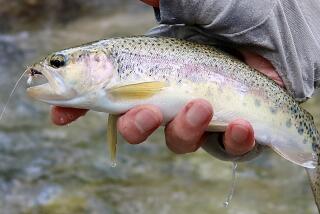Where the River Runs Dry, a Torrent of Change, Pain Follow
EL MAYOR, Mexico — The first time Indians living near the mouth of the Colorado River saw Europeans, they saw trouble.
“They ran toward us [gesturing] with fierce threats to go back where we came from,” an aide to Spanish explorer Francisco Vasquez de Coronado wrote in 1540.
Their descendants probably wish they had been more insistent.
Today, the once mighty Colorado River on which the Indians fished and farmed for 2,000 years is drunk nearly dry by people upstream before it gets to the few Cocopa people still living along the lower reaches.
Where dense forests grew in the Colorado delta now are arid mudflats interspersed with a few struggling, salty wetlands.
Early Spanish explorers often counted thousands of Cocopa people massed in one place, but today fewer than 1,500 remain in the whole region, divided by the U.S-Mexico border. Only 200 to 300 live along the Hardy River, a branch of the Colorado now fed largely by farm drainage.
“It’s almost a miracle that their culture holds together, that we still have people living on the Hardy River speaking their own language,” said Anita Williams, an anthropologist who has studied the Cocopa.
Fully 1,450 miles long, the Colorado stretches from its headwaters in the Never Summer Wilderness Mountains of Colorado to the Gulf of California in Mexico.
By the time it reaches its last, brief stretch in Mexico, 90% of its normal flow has been drained away by U.S. cities and farms.
As soon as it crosses the border, the farms and cities of Mexico’s borderland take what is left. Concrete channels disperse river water to nearly 500,000 acres in the Mexican desert, creating an agricultural bonanza in a place where rainfall averages less than 3 inches a year.
The valley along the river south of Mexicali produces roughly 10% of Mexico’s wheat, about 17% of its cotton and important quantities of sorghum, alfalfa and asparagus.
Even when there are heavy rains upstream, a few steel culverts under a gravel road can handle what was once called “an American Nile” as it limps toward its mouth in the Gulf of California.
In dry years, the river is devoid of water. Between 1961 and 1978, when reservoirs were slowly filling behind upstream dams, there was almost no water in the lower channel.
“The water was finished. Everything was finished,” said Rosario Garcia, a 60-year-old Cocopa fisherman.
The main Cocopa settlement in Mexico is El Mayor, a scattering of plywood and cement-block shacks along a few dirt streets. It doesn’t even show up on maps.
The Cocopa people in the United States have fared somewhat better. The 800-member tribe there has a casino and irrigated land. There are programs to teach the endangered language.
In Mexico, “there are many programs, but none of them reach here,” complained Victor Navarro, head of the Cocopa community. His office in Mexicali has no telephone.
Fishing remains crucial to the El Mayor Cocopa. Mexico’s government has recognized their exclusive right to fish in the environmental preserve at the northern end of the Gulf of California, a spawning ground for many of the gulf’s fish.
Garcia said there are still many fish, but fewer than when the Colorado flowed steadily into the sea, creating a zone of brackish water favored by many species. He also said poachers raid the area, using tight-mesh nets that capture small fish.
The environment was not a major issue when a 1922 agreement divvied up the Colorado among the thirsty American states. Rights to the river already exceed its normal flow, so finding water for preserving wildlife and fisheries can be difficult.
The filling of the upstream dams means river water again reaches the gulf in wet years, although the flows can be erratic. But while demands on the river swell, some wetlands are growing anew in the delta, almost by accident.
Efforts in the 1970s to provide less-salty water for Mexican farmers revived the Cienega de Santa Clara, a major wetlands that had shrunk to about 500 acres. A ditch to divert salty runoff from an Arizona irrigation district helped the wetlands grow to about 50,000 acres, creating an important habitat for migrating birds.
A 1996 study by the Global Water Policy Project and the Pacific Institute listed other possible ways to help the delta: A small reservoir could expand the wetlands along the Hardy River, or treated sewage could be channeled into the area.
“I think every little bit of water that reaches the region has been proven to do some good,” said the Pacific Institute’s Jason Morrison, a coauthor of the study.
More to Read
Sign up for Essential California
The most important California stories and recommendations in your inbox every morning.
You may occasionally receive promotional content from the Los Angeles Times.










